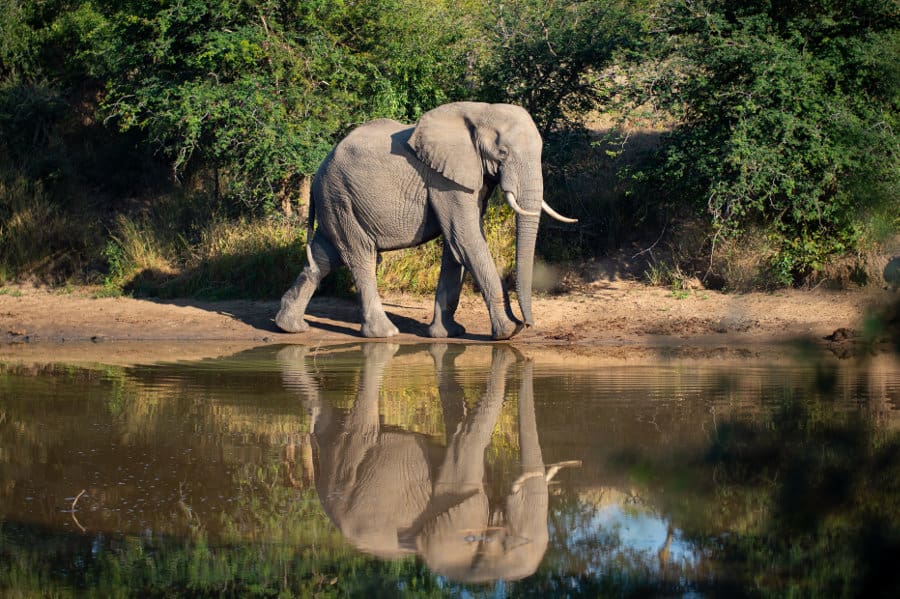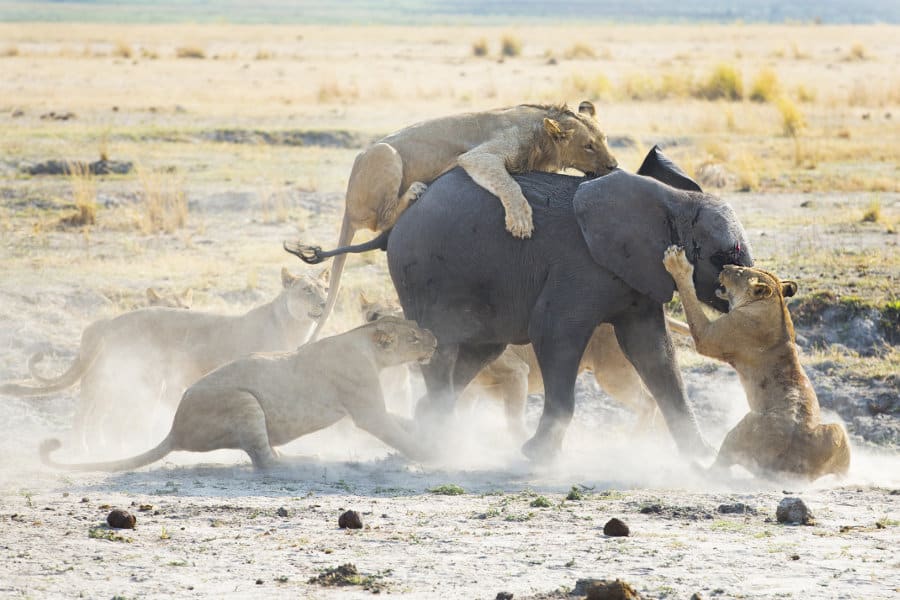Only recently was the elusive African forest elephant defined as a separate and distinctive species. At first glance, it may be easy to understand why. As there are no glaring differences between the forest elephants and their savanna relatives.
However, these awesome forest elephants are deserving of their own title. They are unknowing eco-warriors for their habitats and buzzing ecosystem.
Unfortunately, African forest elephants are an endangered species and their numbers are declining. Living in dense forests, with small populations, they are a rare and wonderful sight.
This guide breaks down the best places to see these elusive African forest elephants. But first, here’s a bit of context.
African Forest Elephant Habitat
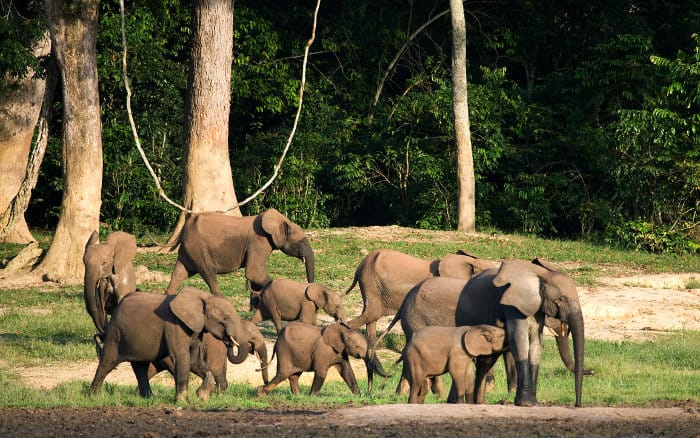
As the name suggests, African forest elephants inhabit African forests. The forest elephant is primarily found in both west and central Africa. Unlike the savanna elephant which is widely dispersed throughout the continent.
The forest elephants have adapted to living in dense, tropical forests. Their straight tusks and smaller size allow them to move through the dense vegetation. Unluckily for wildlife enthusiasts, the rainforest habitat makes it difficult to track and spot them.
Where to See the African Forest Elephants
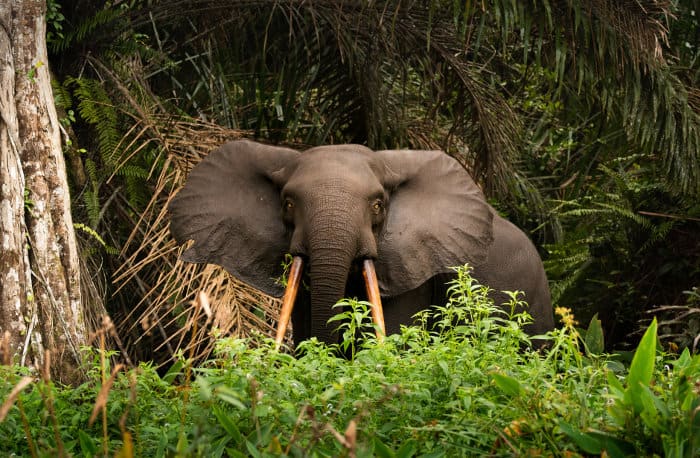
The African forest elephant population has dwindled in the past few decades. There are only a handful of countries in central and west Africa that are home to these jungle giants. Unfortunately, conflict-torn areas and a lack of transport make it difficult to get to a lot of these remote places.
On the other hand, some countries have such a small number of forest elephants that it would be unlikely to spot them on safari. Gabon, for example, is safe for tourists but has a very low number of forest elephants.
Evidently, spotting them requires some careful forward planning. Below is a list of the countries with the best national parks and the highest density of these wonderful creatures.
Uganda
There are a few national parks and forest reserves where you can spot the rainforest elephants in Uganda. Some herds are native to the country. But there are also migratory herds from the DRC.
These are the top two places to see African forest elephants in Uganda.
- Kibale Forest National Park – Uganda’s most diverse forest and one of the only truly tropical forests in East Africa. The landscape varies from thick forests to savanna grasslands and is a haven for primates and forest elephants.
- Bwindi Impenetrable Forest National Park – Located in south-west Uganda on the edge of the Great Rift Valley. This park is only a stone’s throw away from the DRC. You can see migratory elephants and native populations here.
The Democratic Republic of Congo
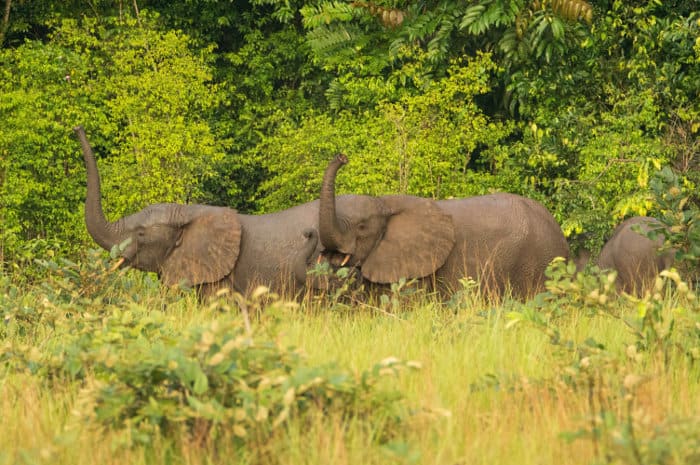
The DRC is not the most tourist-friendly travel destination due to the ongoing conflicts that plague the country. However, this national park is safe for visitors and a popular gorilla trekking destination for foreigners.
It is also a hot spot for African forest elephants.
- Virunga National Park – A UNESCO world heritage site in eastern DRC. This park is the most biologically diverse protected area in Africa. Here you can witness dedicated conservation of native endangered species. Including the forest elephant.
The Republic of Congo
The Republic of Congo is safer and more accessible than the DRC. The country is incredibly diverse and teeming with wildlife.
Visit this exciting national park to see the forest elephant and many other amazing animals.
- Odzala-Kokoua National Park – One of Africa’s oldest national parks, Odzala-Kokoua boasts unbelievable diversity. And it’s home to the largest population of forest elephants in central Africa. The forest buffalo and lowland gorilla are also a part of the endangered wildlife population here.
Cameroon

The forests of Cameroon have some of the highest density populations of African forest elephants. Many of these areas are in pristine condition due to the lack of visitors to Cameroon. Making it a wild and beautiful spot to see forest elephants.
Consider two of the best parks in Cameroon for your forest elephant safari.
- Lobéké National Park – The park stretches across the border into reserves in the Central African Republic and the Republic of Congo. It has the highest concentrations of forest elephants and lowland gorillas.
- Korup National Park – A very diverse lowland rainforest and swamp forest. The park borders Nigeria and is one of the most visited parks in Cameroon. It is a true jungle experience.
The Central African Republic
The Central African Republic is undoubtedly one of the wildest countries to spot forest elephants. There are vast areas of untouched rainforests that are teeming with wildlife.
Check out the country’s best national park.
- Dzanga-Sangha National Park – a UNESCO world heritage site home to tropical rainforests, wetlands and swamps. The forest clearings are great for spotting forest elephants. A truly wild area with a range of unique forest mammals.
So, now you know where to find them, let’s take a closer look at these wonderful creatures.
African Forest Elephant vs African Savanna Elephant

- It’s all in the ears. The savanna elephant has large pointed ears that look a bit like the African continent. The forest elephant has slightly smaller, oval-shaped ears. Taking into consideration the size of both species ears, neither have a problem with hearing.
- Both species of elephants have impressive ivory tusks. But, the forest elephants have straighter tusks which point downwards. While the savannah elephant’s tusks curve outwards.
- The forest elephants are, albeit slightly, smaller than the savanna elephants. Savanna elephants are behemoths, reaching up to 13ft tall and up to 7 tons. The forest elephants have a more modest maximum height of 10ft and a weight of 6 tons.
- Look to the toes! The forest elephant has five toenails on its front feet and four on its hind feet, which is similar to the Asian elephant. The savanna elephant only has four nails on its forefeet and three on the back feet. Toe-tally crazy! 🙂
African Forest Elephant Facts
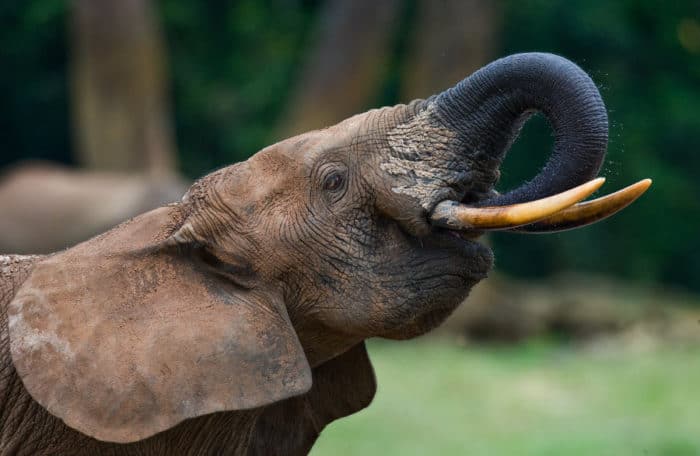
- They love salt and go searching for salt and minerals in the soil and at salt licks.
- They are herbivores, eating a diet filled with leaves, high amounts of fruit, and tree bark.
- They have the slowest reproduction rate of the three elephant species.
- They are essential for the germination of forest trees. The elephants eat the seeds which then germinate in their dung.
- The life expectancy of forest elephants is between 60 and 70 years.
- Males reach a maximum height of 10 feet and a maximum weight of 6 tons.
- The average gestation period is around 2 years.
Bonus Dung Knowledge: It’s difficult to count forest elephants in their dense habitat. Overgrown forests make identifying the animals hard. Therefore, dung counts are used to collect data density and distribution and to calculate the population size.
The African Forest Elephant: Ecological Engineers

African forest elephants are imperative to the ecological balance of rainforests. Plants and animals of the forest depend on the elephants for their own survival. As mentioned above, many trees depend on the elephants to germinate and disperse seeds.
These elephants love all kinds of fruit and eat up to 500 different types. Dispersing seeds as they unload.
The elephants create trails in the forest by stomping and destroying vegetation as they walk. This may seem destructive but it opens up miles of tracks through the dense forest which other animals need.
These ecological engineers are instrumental in the complex rainforest biodiversity. They assist many natural processes just through daily behavioral habits.
African Forest Elephant Conservation

Forest elephants suffer the age-old threat from poaching for their ivory tusks. On top of this, their habitat is rapidly shrinking as human populations boom. Deforestation to make space for agricultural land leads to the destruction of habitats.
There is the added problem of human and elephant conflict which stems from habitats being in closer proximity to farms. Distressed farmers often call on professionals to cull ‘problem’ elephants. This is to avoid human injury and any destruction of agricultural land.
On top of all this, their elusiveness makes the forest elephants difficult to protect as herds cannot be effectively monitored.
The survival of this endangered species is crucial to the survival of the entire ecosystem which it inhabits.
Fortunately, organizations such as the African Wildlife Foundation are working hard to compile research in an effort to conserve the species.
Go Find the African Forest Elephant
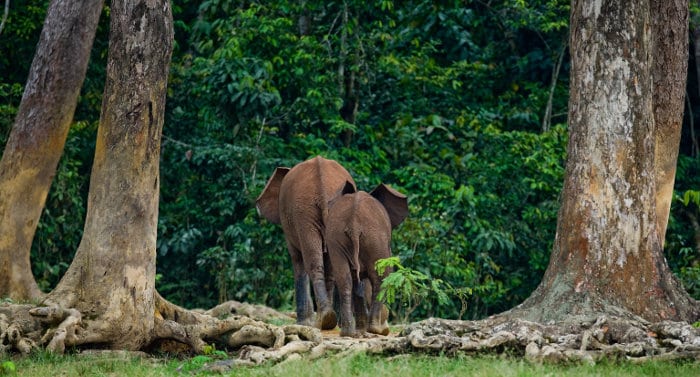
Are you surprised at how unique the African forest elephant is? It’s an amazing mammal, working hard to keep the delicate balance in the forest ecosystems.
While populations are on the decline, there are still a few hot spots where you can observe this incredible species. By going in search of these forest elephants, you will have the thrilling opportunity to discover a rare and endangered species.
In addition, your visits will contribute to the conservation of these endangered animals. It’s an all-round win.
What are you waiting for? Book yourself a safari, adventure into the depths of the African jungle and go find the elusive forest elephant!

